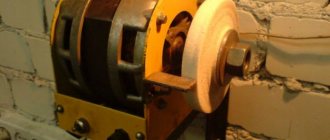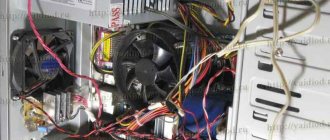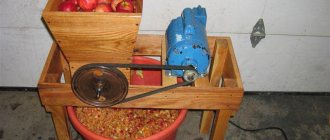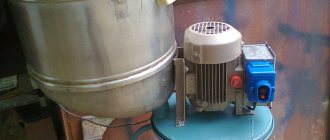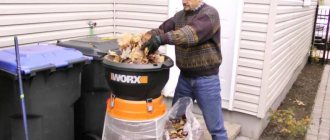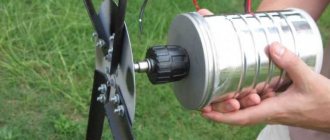Theory of operation of a 220 V electric motor
Asynchronous motors for single-phase networks are mainly motors with two-phase windings and an auxiliary phase taken from a capacitor. Such motors are used in household appliances. A similar motor is used, in particular, to drive a washing machine. In addition to two-phase winding motors, three-phase winding motors are sometimes used in some other household appliances.
During direct starting, the motor can receive a current from the network that significantly exceeds its rated value. This current is called the motor starting current, and its value varies in the region Ir = 5-7In .
One way to reduce the inrush current is to use a star-delta switch. A motor designed to operate the stator in a triangular connection at a given mains voltage is connected to the star system at the time of start-up:
Due to the reduced voltage supplied to the stator winding phase and the change in connections from delta to star, the current taken from the network will be reduced by three times compared to the starting current in a delta circuit. However, when connected to a star, the motor has three times less starting torque, which makes it impossible to use this method during heavy starting (with a heavy load).
What is the power of the SM engine
The performance of the motor depends on its type. Three types of washing machines are used:
- asynchronous;
- collector;
- inverter (brushless).
Asynchronous motor
It was installed in cars manufactured before 2000. The motor of a semi-automatic washing machine has 2800 rotations per minute and a power of 180–360 W. To adapt such an engine for garage “homemade” products, you need a three-phase network, a frequency converter, and a set of capacitors. This is expensive, which is why asynchronous systems are not popular among do-it-yourselfers.
Brushed motor
A favorite of the masters. Powered by direct and alternating electric current, power 300–800 W, number of armature turns 11,500–15,000 rpm. On the plus side, the cycle can be easily adjusted without loss of power. The downside is that the brushes wear out often.
Inverter motor
The most modern and economical look. Converts alternating current to direct current. It operates without a belt drive and brushes with a power of 400–800 W, making a number of turns from 16,000 to 20,000 per minute.
Currently, a commutator electric motor is the best option for home workshops in terms of availability and price. It is versatile and easy to operate. Let's look at its structure, connection and adjustment methods.
Capacitor for electric motor
For small motors (<1 kW), the value of the starting capacitor can be determined from the relationship:
C [uF] = (1800 x Pn) / U2
where Pn [W] – rated motor power, U [V] – supply voltage.
This formula is also suitable for calculating the starting capacitor value for single-phase start-phase motors.
For larger motors (>1kW) a capacitance of around 70uF/1kW is suggested. It is necessary to use starting capacitors with operating voltages of 400..630 V AC.
You can omit the calculations and simply connect a standard motor from the washing machine to 1 phase 220 V through a 7 microfarad capacitor connected between the required terminals. Connect the first power wire to the middle, and the second, depending on the direction of rotation, to one of the capacitor wires. The power drop will be 30% - this is in theory.
The issue of choosing a capacitor is easily resolved. Here are examples of capacitance values for different engine powers.
Pn [W] 90 120 180 250 370 550 750 1100 S [µF] 4 5 6 8 12 16 20 30
Useful: Electrical installation of 220V equipment for apartments and houses
The rotation power in the washing machine is the same in both directions. These are motors with a typical connection for a single-phase motor. The main winding is connected directly to 220 V and a phase winding is connected in parallel with it along with a series-connected capacitor. If you reverse the phase winding wires, the motor will rotate in the other direction, but the power will be slightly less. This circuit works during the spin cycle. The same for slow and fast rotations - the capacitance switches inside the washer from 7 µF to 16 µF. Read more about the capacitor here
Frequent breakdowns: what you might encounter
We now know how to connect an electric motor from an old washing machine. But there are situations when the engine does not start. What are the reasons and ways to solve such a problem?
Try to check the condition of the motor heating after running it for three minutes. In such a short time, all parts cannot heat up equally, so you have the opportunity to identify the fault location that will be too hot. This could be a bearing assembly, stator, etc.
Various engine malfunctions
The main reasons why a particular part is too hot may be the following:
- clogged or failed bearing;
- excessively expanded capacitor capacity.
Connecting the motor from the SMA
This motor contains two independent windings:
for synchronous speed 3000 rpm - two-phase winding.
for synchronous speed 500 rpm - symmetrical three-phase winding . The three-phase connection system allows you to change the rotation speed by switching the power supply to the winding.
An older type motor usually has 5 wires, black, blue, white, red and green. A series of measurements were carried out to determine the windings and the resistance between them:
- Blue-black 85 Ohm
- Blue-green 85 Ohm
- Black-green 80 Ohm
- White-blue 15 Ohm
- White-red 30 Ohm
Connecting an old electric motor requires finding the starting winding using a multimeter.
- ON - initial winding . It is designed to start the engine only and starts at the very beginning until the engine begins to rotate.
- OB – field winding . This is the work winding that runs constantly and constantly turns the motor.
- SB – button from which voltage is supplied to the starting coil and turned off when the engine starts.
What is needed
- A toggle switch with two groups of contacts 220 V 15 A, you can purchase it on Ali Express
. - Speed controller 400 W 220 V 50 Hz, also get it on Ali Express
. - An electric motor from an automatic washing machine will suit almost any brand.
- Pieces of wires of different colors, preferably blue (zero) and brown (phase).
- You will need electrical tape; to install a powerful radiator, buy a new one and a tube of heat-conducting paste.
- To check the connection diagram, it is recommended to use an ordinary tester or at least an indicator.
Connecting the electric motor from a new washing machine
If you look at the terminal block with the wires on the front, usually the first two wires on the left are the tach wires, which measure and regulate the rotation speed of the washing machine motor. We don’t need them - they are crossed out with a cross.
In different models of washing machines, the wires differ in color, but the connection principle remains the same. You just need to find the necessary wires by testing them with a multimeter.
A working tachogenerator in a quiet state usually has a resistance of 50-100 Ohms. You will immediately find these wires and disconnect them.
If you need to change the engine speed in the opposite direction, simply drag the jumper to the other pins. Look at the diagrams to see what it looks like.
Two contacts go through the brushes to the rotor windings, and the other two contacts go to the stator winding. The remaining contacts are a sensor for measuring the motor rotation speed. The rotor and stator windings are connected in series and by changing the ends of one of the windings, you change the direction of rotation. Without an electronic regulator, the engine will accelerate to several thousand revolutions per minute (as at maximum spin).
- Read how to regulate the motor rotation speed from the SMA here.
How to adjust rotation
There are many ways to control speed:
- laboratory autotransformer;
- adjustment board for household appliances;
- screwdriver buttons, grinders;
- lighting regulators (switches, toggle switches).
The adjustment scheme is simple, you can do it yourself.
This is a satisfactory option for a pump or fan. For more powerful mechanisms (for example, machine tools), a different regulator circuit will be needed.
Read also: What is the difference between a technological map and a technological process
The essence of the question is how to reduce speed without losing performance? The connection is made through a tachogenerator, which transmits the number of turns to the speed controller microcircuit, which coordinates the cycle using a thyristor.
Such a board allows you to either increase or decrease the speed, but requires constant, intensive cooling due to overheating. A detailed video about how the speed and power of the stroke are regulated by connecting to the microcircuit can be viewed here:
Now you know what speed different types of engines make and how to set up this process in your home workshop. Good luck!
Washing machines, like any household appliance, tend to break down. And it’s good if the breakdown can be corrected at low financial cost. But alas, there are times when there is no point in repairing a washing machine, since it is easier and cheaper to buy a new unit. But what to do with the old one? Moreover, if its engine is in excellent condition and continues to work properly.
Speed control relay
Speed controller, my modification
If you bought inexpensive Chinese products, then you should definitely check the device. Remove the filling from the case and pay attention to the triac. At best, it has a very small heatsink that cannot effectively remove heat. In the worst case, there is nothing at all.
Cut an M3 thread on the new radiator and adjust its length to the dimensions of the case. Spread the surface of the triac with thermal paste and secure the prepared radiator. Assemble the regulator.



